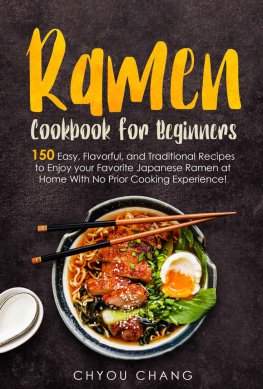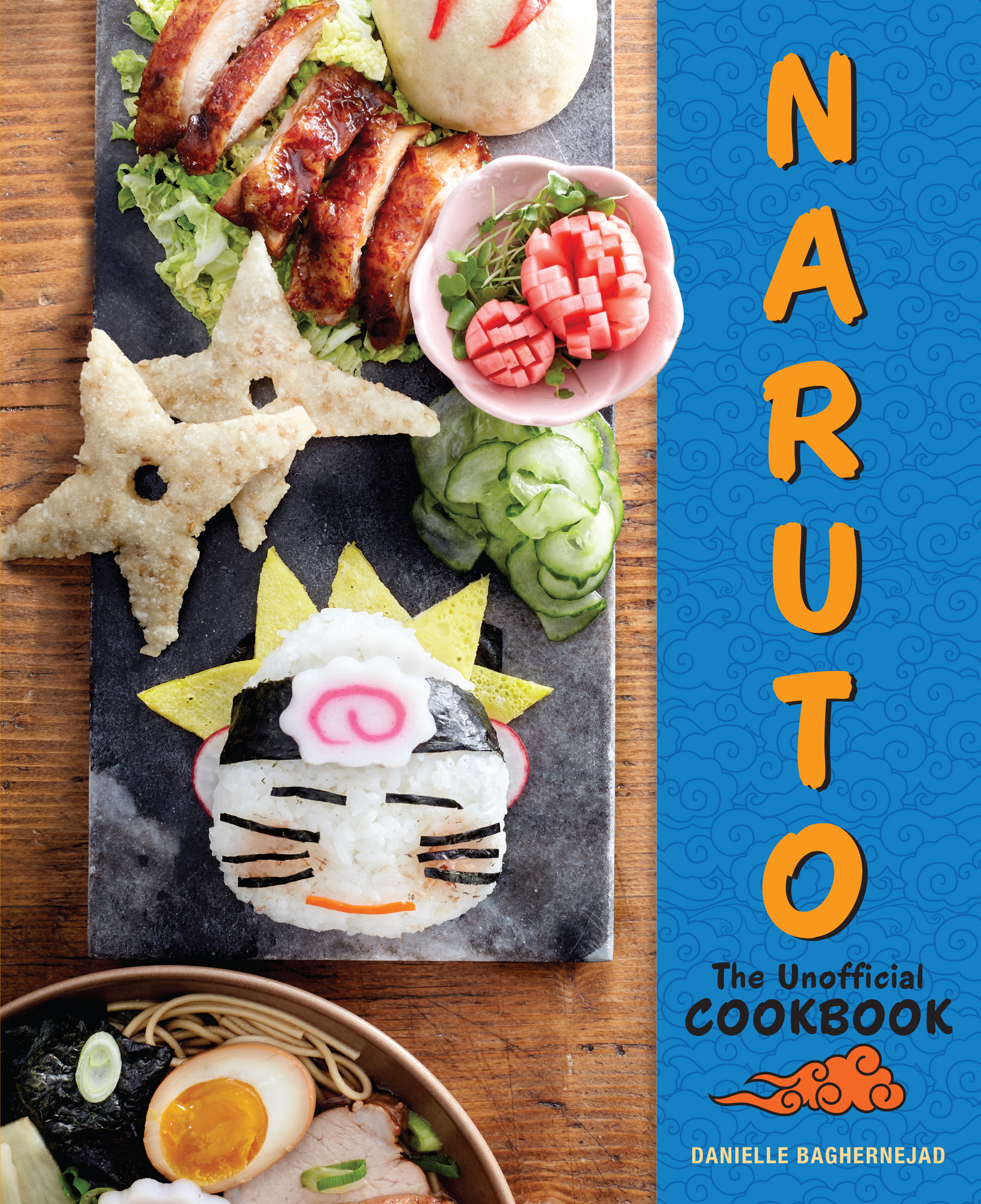Contents
Guide
Naruto: The Unofficial Cookbook
Danielle Baghernejad
INTRODUCTION
Given that Naruto is also the name of a popular ramen topping, its no surprise that food has a special presence in the Naruto anime and manga. From iconic moments, like experiencing the Curry of Life, to everyday scenes of villagers enjoying dumplings at a small street stall, food itself often is an important character in the series! As fans, its only natural that we celebrate the wide array of food seen on the show. And, of course, finally get our chance to eat it!
The dishes gathered in this book are an assortment of food seen in, and inspired by, the world of Naruto. Ichiraku Ramen, the noodle shop where Naruto is practically a full-time resident, is a prominent example. But character favorites, like Chjis Chips, and inspired dishes like Kuramas Nine-Tails Kitsune Udon, will immerse youand your appetiteeven further in the shinobi world.
The food depicted in Naruto is heavily influenced by Japanese cuisine, so this book also serves as a good introduction to Japanese-style cooking. To help you advance from a cooking Genin to a kitchen Hokage, each chapter begins with a ninja mission that will teach you an essential skill or technique. As in the missions doled out by high-ranking shinobi, each of these assignments is ranked from D (beginner) to B (advanced). (Sorry, Genin, no A- or S-ranked missions for you!) Once you complete them, your knowledge of Japanese cuisine will be solid enough to see you through any future culinary challenges that come your way!
THE COOK-NINS PANTRY
Like every cuisine, Japanese cooking has its own special ingredients that make it what it is. Some, like soy sauce, youre likely already familiar with, but others, like kombu, may be new to you. Most of the ingredients needed in this book can be found in your local grocery store, which is a good place to start your searchyou may be surprised to see whats available in that international aisle that you usually skip past. But for others, you might need to visit an Asian grocery store or search online. (Which is much easier than traveling to the Forest of Death!) Many of these can be bought bottled, canned, or dried, so buy in bulk and stock up.
ABURAAGE
Availability: Challenging
A type of tofu product, aburaage is made by deep-frying thinly sliced tofu. It is usually prepared by cutting it into strips, or along the side and then opened like a pocket, similar to pita bread. Its often served seasoned, and preseasoned aburaage can be found in cans, but plain aburaage is typically sold frozen.
BAMBOO SHOOTS
Availability: Moderate
These are the young shoots of the bamboo plant. Fresh bamboo shoots are a symbol of spring and available for only a short time. Canned bamboo shoots are available all year.
BONITO FLAKES
Availability: Challenging
Labeled as katsuobushi in Japanese, these are shavings from dried bonito fish (a relative of mackerel and tuna). Bonito flakes are a staple in Japanese kitchens, used as the basis for making dashi, but also as a topping to sprinkle on pretty much anything.
DAIKON RADISH
Availability: Challenging
A large, round white root vegetable, daikon has a crunchy texture. Its a great addition to stir-fries and stews, excellent for pickling, and also popular to grate and use as a condiment alongside meat dishes.
Substitutions: If necessary, you can substitute regular radishes for texture, but the daikons flavor is more peppery.
DASHI
Availability: Moderate
Made from bonito flakes and seaweed, this is the basic stock used in Japanese cooking. Youll learn how to make your own in the first chapter of this book! Otherwise, instant dashi granules are quite an excellent substitute, and sold in little bottles that you can keep on hand.
Substitutions: Chicken or vegetable broth
EDAMAME
Availability: Easy
These green young soybeans have become increasingly popular in the West. Youll find them sold both shelled and unshelled. Theyre typically found in the frozen food section of your supermarket.
FURIKAKE
Availability: Moderate
A dry or semidry condiment thats sprinkled on top of dishes, furikake typically contains sesame and seaweed, alongside a few other flavorings. Its easy to make yourself, as youll see in the first recipes of this book!
GINGER
Availability: Easy
Youre probably familiar with this pungent kitchen spice in some form already, but were not talking about the powdered ginger in the spice cabinet! Fresh ginger root is used extensively in Japanese cuisine. Keep fresh ginger wrapped in plastic wrap in the fridge or freezer between uses.
HARUSAME
Availability: Moderate
Translated as spring rain, harusame is the Japanese word for Chinese cellophane or glass noodles. Sold dried, they are very thin and translucent when cooked.
JAPANESE RICE
Availability: Easy
The most common type of rice in Japan is medium-grain rice, sometimes labeled as sushi rice. It has a unique, sticky texture that other types of rice cannot replicate. Getting your hands on good Japanese rice is essential for sushi and onigiri.
KOMBU
Availability: Challenging
This thick, dark, leathery dried seaweed is used mainly for making dashi. A little goes a long way in terms of flavor.
MIRIN
Availability: Moderate
A sweet, fortified rice-based liquor, mirin is used for cooking, never drinking. Mirin is one of the core flavors in Japanese cooking, and its essential in recipes for the most authentic taste. Hon-mirin is naturally made mirin with about 20 percent alcohol content, whereas aji-mirin is an almost alcohol-free mirin substitute.
Substitutions: Sweet sherry, marsala wine, white grape juice
MISO
Availability: Moderate
A salty fermented soybean paste, miso is often made with wheat, rice, or barley mixed in. Its highly nutritious, and delicious. The most versatile type is white miso (actually a light brown color). Miso keeps practically forever in the fridge, so dont be afraid to buy a larger container.
MOCHI
Availability: Challenging
These Japanese rice cakes can be found in many varieties, some sweetened, some stuffed, some flavored, some plain. When including them in recipes, youll want to use a plain variety, typically sold dried and individually sealed. If youre lucky, though, youll find fresher mochi in the refrigerated or freezer section of Asian groceries.













